
According to a report, published by CNBC, it was observed that–60% of workers reported feeling emotionally disconnected from their jobs, 19% described their feelings as miserable, and only 33% of employees mentioned they felt engaged at work. This issue of very low rates of job satisfaction has been persisting for many years, serving as an obstacle for businesses striving to sustain economic growth.
To tackle this issue, businesses can implement a performance-based compensation model such as pay-for-performance (P4P), where employee compensation is directly tied to their individual performance metrics, which in turn boosts employee motivation and productivity, with them feeling much more engaged at work. By aligning rewards such as bonus payments with the completion of personal milestones or organizational objectives, this additional compensation drives the employees towards supporting the company to reach its organizational goals as a result of collective success.
In this article, we will discuss the various pay-for-performance programs, explaining how each model can be tailored to meet different organizational needs and how performance-based pay can help enhance overall organizational goals effectively.
Pay-for-performance (P4P) is a compensation model that enhances an employee’s base salary based on their ability to exceed specific quality thresholds and performance metrics. This approach is often viewed as a more equitable method of rewarding employees with additional payments, who demonstrate exceptional effort and surpass performance expectations compared to traditional salary structures.
The pay for performance plan essentially revolves around providing financial rewards to employees who exhibit outstanding performance in the workplace, along with integrating professional development opportunities and recognition programs to keep them motivated and engaged in their growth and contributions to organizational success. The P4P model often incorporates non-discretionary bonuses, providing structured incentives based on set criteria rather than subjective performance appraisals.
Research indicates that 81% of high-performing companies leverage some form of P4P practices, in contrast to 74% of average companies. This data underscores the positive correlation between performance-based compensation strategies and overall organizational success. 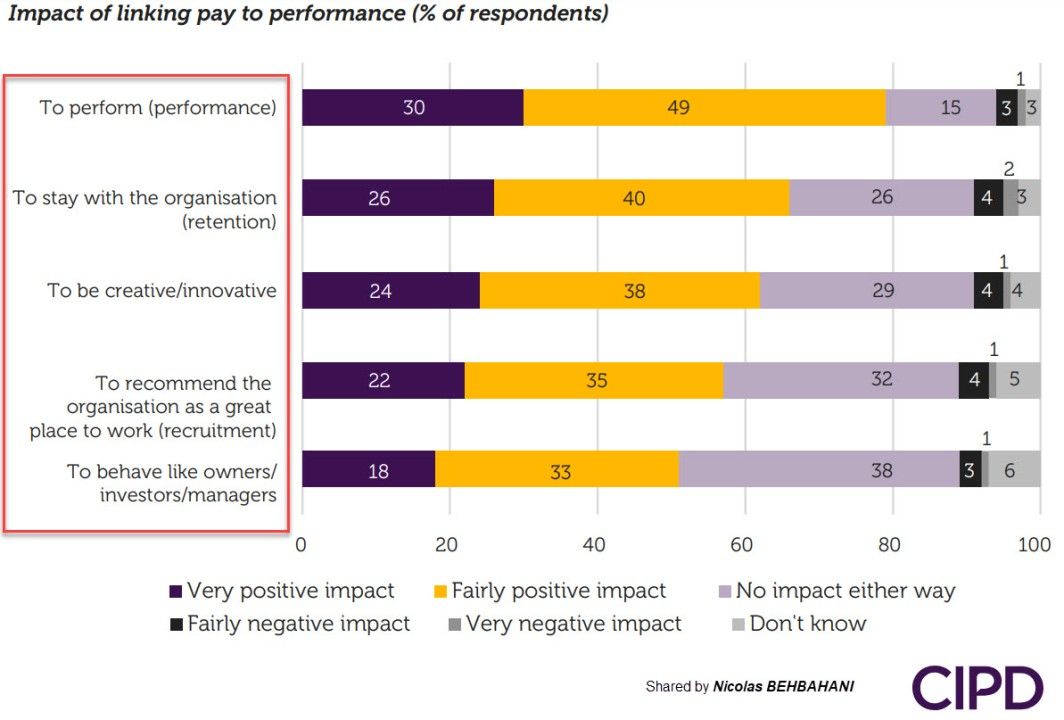
Source - LinkedIn
While traditional compensation models have long been the standard in many organizations, their inherent limitations- such as lack of performance outcomes and rigidity—often anchor employee motivation and engagement, making it crucial to explore more effective alternatives, as highlighted in the following table.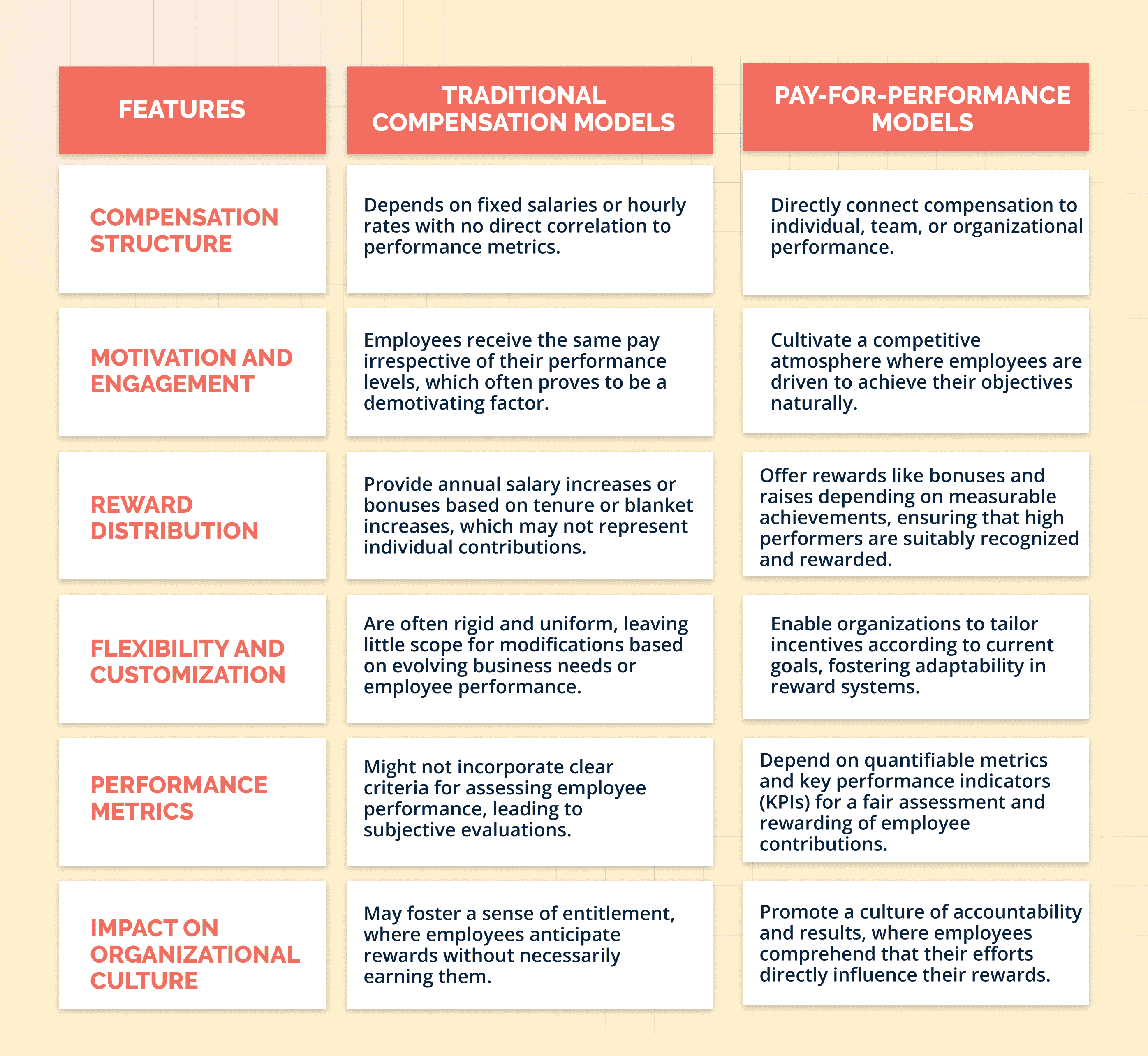
Several pay-for-performance-based compensation models can effectively boost an organization's performance, and sustain economic growth. These include:
Merit pay connects salary increases directly to an employee's performance, rewarding personal accomplishments or providing team-based incentives, and fostering a culture of continuous improvement. This additional compensation helps them feel comfort in knowing that their efforts are being recognized and keeps them motivated to achieve their performance targets and navigate through excessive work pressure.
This approach links financial rewards directly to key performance indicators (KPIs), helping to drive higher ROI through consistent talent nurturing.
A bonus is a financial compensation that is paid over and above the regular salary for good performance, project achievement, or other reasons. These rewards are typically tied to short-term objectives, such as meeting sales quotas, completing projects, or surpassing productivity benchmarks, and aim to boost motivation amongst the ones putting in the extra effort.
These financial bonuses are sudden and often come as a surprise. Providing immediate compensation enhances motivation among those who go above and beyond in their work.
Companies like TATA Motors, CISCO, and Infosys are known for offering lucrative financial incentives such as bonus programs during key performance periods, project completions, and annual appraisals.
Skill-based pay is a compensation system where the basis for reward is determined by the use of the employee's specific skillset in their job role. This method encourages employees to acquire more skills and make greater contributions to organizational objectives. By promoting skill enhancement, companies encourage ongoing learning and career advancement, resulting in better performance results. Skill-based pay not only boosts employee engagement but also assists organizations in remaining competitive by ensuring they possess a highly capable workforce.
A Profit-Sharing-Programme (PSP) is a compensation program that allows a business of any size to distribute a portion of the company's pre-tax profits to employees, which is generally tax-deductible in amounts up to 25% of the company's payroll. The plan creates a sense of ownership and alignment between employees and the company's financial performance. Numerous companies provide profit sharing as a retirement benefit for their employees. This fosters a shared sense of accountability for financial outcomes.
Some of the famous companies that have implemented profit-sharing plans that have been successful in rewarding their employees, boosting motivation at work, and contributing to retirement savings include: Home Depot, Walgreens, and Buffer.
Commission-based pay is a form of compensation where sales representatives earn a portion of their income as commission on sales they make. This commission can be delivered as an extra financial incentive on top of their base salary. These financial bonuses act as a factor that helps motivate employees to work at their full capacity, as the number of sales that are generated is in a 1:1 ratio with the amount of commission earned.
Stock options are a type of equity compensation that allows an employee to purchase a defined number of shares at a predetermined price. Many private firms and corporations incorporate them into their compensation plan for potential job candidates. Companies frequently include stock options within the compensation package to allow employees to benefit from the company’s achievements. these performance programs help build a positive work culture and a dedicated workforce.
It’s been observed through the years that growing companies with stock options, have a higher percentage of employee retention as the stock options directly or indirectly keep the employee invested in the company’s success.
Yes, performance compensation models can also be seen in health care. P4P in healthcare is a model that directly links financial incentives to the efficiency and quality of care provided. This approach rewards healthcare providers based on meeting specific metrics like reducing hospital readmission rates, managing chronic conditions, and enhancing patient satisfaction. The intent is to foster accountability and show improvements in care quality; however, it can lead to unintended consequences like limited access for high-risk patients if performance metrics are too narrowly defined.
Some examples are:
Healthcare providers face penalties for high readmission rates for specific conditions, which can motivate improvements in discharge planning and follow-up care. However, this may unintentionally discourage providers from admitting patients who truly need care, potentially affecting access to services.
Physicians receive bonuses for reporting quality measures related to patient care, such as managing chronic conditions like diabetes, high blood pressure, etc. This system ensures that healthcare providers focus on effective treatment and helps in the reduction of mortality rates but may lead to insurance companies favoring specific treatments over others, depending on reported metrics.
Hospitals are rewarded based on quality metrics, such as patient satisfaction and clinical outcomes, rather than the volume of services provided. This promotes a patient-centered approach but could inadvertently lead to providers avoiding complex cases, including those related to pulmonary diseases, where clinical outcomes can be challenging to manage.
Groups of healthcare providers collaborate to deliver coordinated care and share savings from improved efficiency and quality. While this incentivizes teamwork and drives better health outcomes for patients, it may create disparities in service provision if some ACOs struggle to meet the standards set forth.
Providers receive bonuses for achieving health metrics in patients with chronic diseases, promoting proactive management, and ensuring high-quality care. However, if the metrics do not capture the complexity of managing certain conditions, such as pulmonary diseases, this can lead to gaps in patient care.
These P4P initiatives aim to enhance the quality of care in the healthcare sector while fostering accountability among healthcare providers. Nevertheless, it is crucial to address any unintended consequences that may arise to ensure equitable access to services for all patients.
Designing a rewards system that consistently drives high performance remains a significant challenge for leading organizations. Traditional compensation models do offer all the basic financial incentives but lack the flexibility and customization needed to engage top talent. P4P is a performance-based compensation strategy that, through linking rewards such as additional payments, and other incentives to individual and team-based incentives, would help organizations build a result-oriented culture.
Implementing P4P strategies, however, comes with its own set of challenges, such as performance tracking, goal alignment, and maintaining fair, transparent evaluations, and regularly scheduled payments. That is where tools like CompUp prove to be invaluable. CompUp facilitates real-time feedback and data-driven tracking, ensuring after careful consideration that employees are recognized and rewarded through financial bonuses based on their achievement of defined performance goals. By incorporating performance systems like CompUp, organizations can streamline their P4P initiatives, making them more effective and impactful.
In today’s competitive business environment, creating an engaged, high-performing workforce is essential for sustainable success. By implementing a P4P model with tools like CompUp, organizations can not only reward top talent but also build a transparent and motivational company culture. With its capabilities in real-time feedback, data-driven performance tracking, and goal alignment, CompUp empowers companies to recognize and reward talent in ways that align with their strategic objectives. For organizations aiming to elevate employee motivation, and employee retention, and constantly boost team performance-- CompUp offers a powerful solution to bridge the gap between performance and reward, positioning them for growth and long-term success.
For organizations implementing performance-based compensation models, tracking the basis for reward by job level can highlight salary compression issues and ensure fair compensation growth across career stages.
CompUp’s Increment Distribution feature allows companies to view salary progression between entry-level and senior roles, offering critical insights into whether increments align with job responsibilities and performance expectations.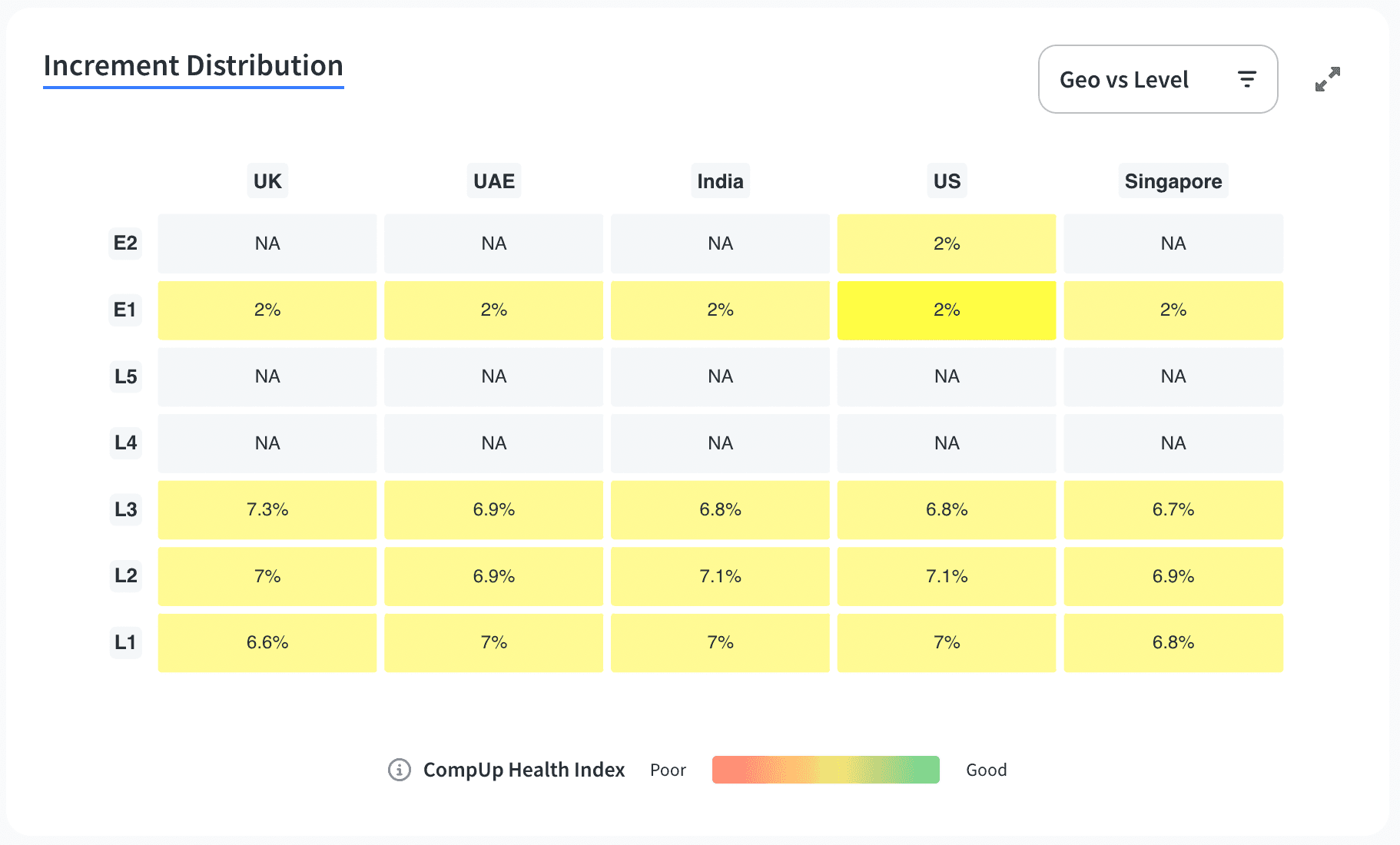
CompUp has a budget utilization dashboard from where you can see the results of budget simulations and get relevant insights on how to streamline your budget planning. 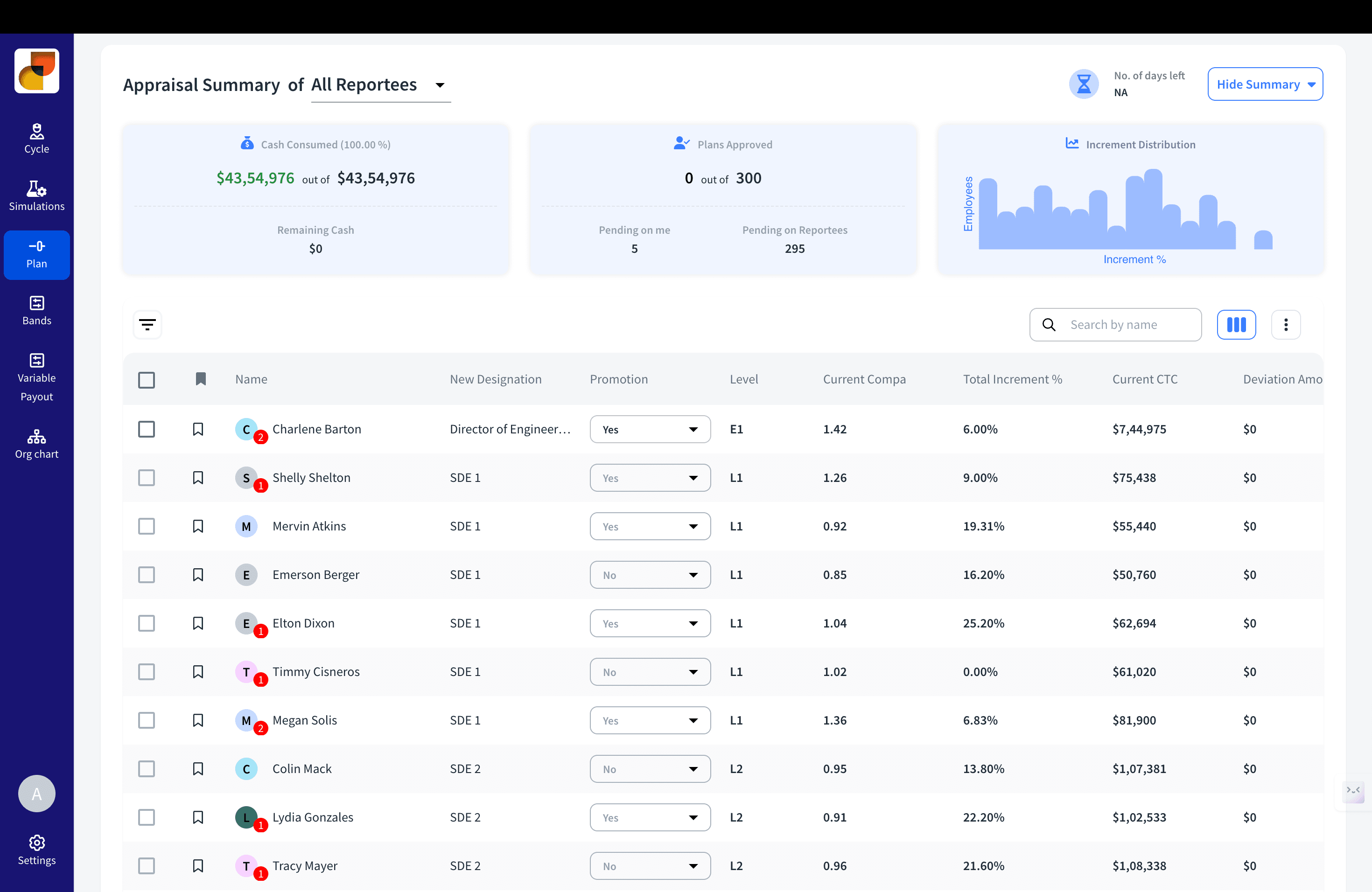
The platform also provides a section for peer comparison to understand the merit planning standards of your competition and help you create competitive compensation packages. 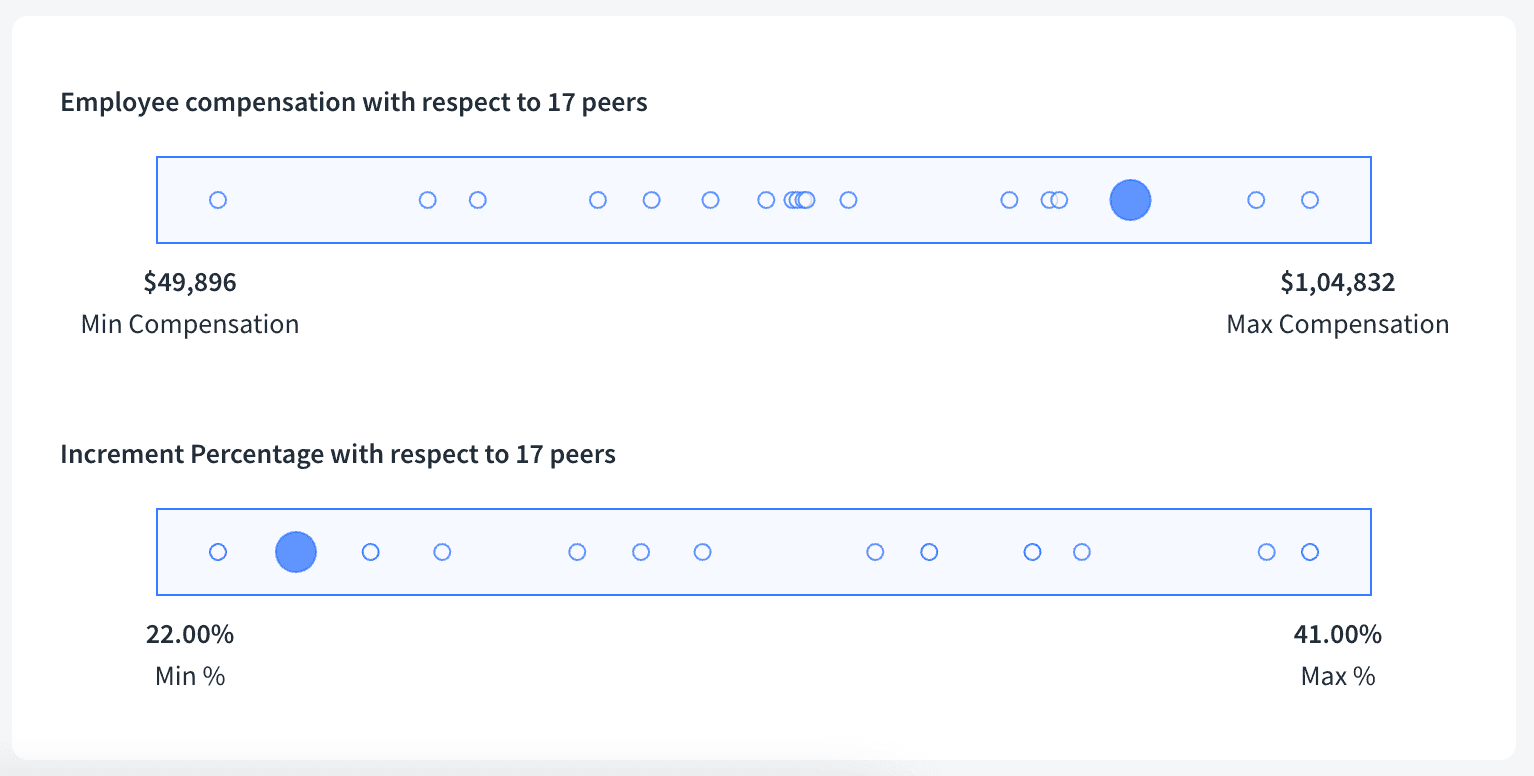

For companies seeking to leverage a performance-based compensation model, CompUp provides a sophisticated, user-friendly platform for smooth goal alignment, accurate performance tracking, and personalized recognition. By aligning performance programs with rewards or financial bonuses, CompUp drives engagement and builds a high-performance culture that directly supports long-term organizational success.
With advanced tools for tracking individual contributions, CompUp empowers companies to recognize top talent effectively, enhancing motivation and retention. Its Total Rewards statements offer employees clear insights into their compensation packages, fostering transparency and loyalty. By integrating CompUp, organizations can optimize their P4P strategies and performance initiatives, positioning themselves as employers of choice in today’s competitive talent market.
Revolutionizing Pay Strategies: Don't Miss Our Latest Blogs on Compensation Benchmarking